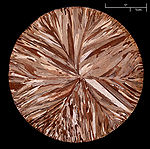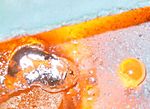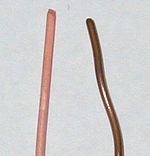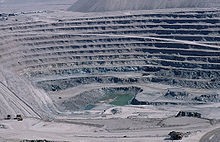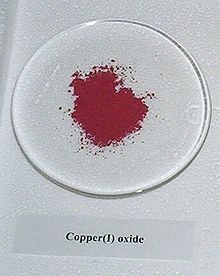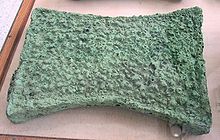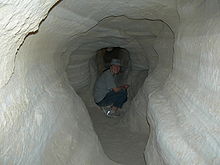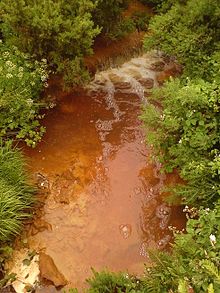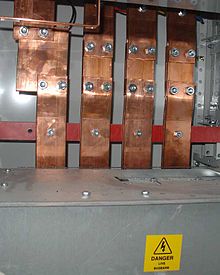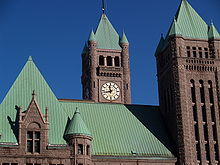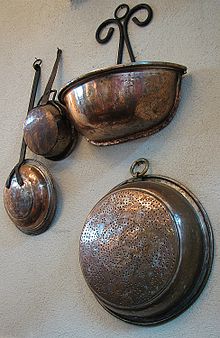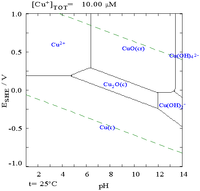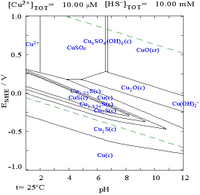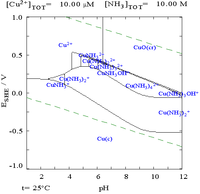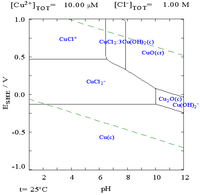- Copper
-
nickel ← copper → zinc -
↑
Cu
↓
AgAppearance red-orange metallic luster

Native copper (~4 cm in size)General properties Name, symbol, number copper, Cu, 29 Pronunciation /ˈkɒpər/ kop-ər Element category transition metal Group, period, block 11, 4, d Standard atomic weight 63.546(3) Electron configuration [Ar] 3d10 4s1 Electrons per shell 2, 8, 18, 1 (Image) Physical properties Phase solid Density (near r.t.) 8.94 g·cm−3 Liquid density at m.p. 8.02 g·cm−3 Melting point 1357.77 K, 1084.62 °C, 1984.32 °F Boiling point 2835 K, 2562 °C, 4643 °F Heat of fusion 13.26 kJ·mol−1 Heat of vaporization 300.4 kJ·mol−1 Molar heat capacity 24.440 J·mol−1·K−1 Vapor pressure P (Pa) 1 10 100 1 k 10 k 100 k at T (K) 1509 1661 1850 2089 2404 2834 Atomic properties Oxidation states +1, +2, +3, +4
(mildly basic oxide)Electronegativity 1.90 (Pauling scale) Ionization energies
(more)1st: 745.5 kJ·mol−1 2nd: 1957.9 kJ·mol−1 3rd: 3555 kJ·mol−1 Atomic radius 128 pm Covalent radius 132±4 pm Van der Waals radius 140 pm Miscellanea Crystal structure face-centered cubic Magnetic ordering diamagnetic Electrical resistivity (20 °C) 16.78 nΩ·m Thermal conductivity 401 W·m−1·K−1 Thermal expansion (25 °C) 16.5 µm·m−1·K−1 Speed of sound (thin rod) (r.t.) (annealed)
3810 m·s−1Young's modulus 110–128 GPa Shear modulus 48 GPa Bulk modulus 140 GPa Poisson ratio 0.34 Mohs hardness 3.0 Vickers hardness 369 MPa Brinell hardness 874 MPa CAS registry number 7440-50-8 Most stable isotopes Main article: Isotopes of copper iso NA half-life DM DE (MeV) DP 63Cu 69.15% 63Cu is stable with 34 neutrons 65Cu 30.85% 65Cu is stable with 36 neutrons Copper (
 /ˈkɒpər/ kop-ər) is a chemical element with the symbol Cu (from Latin: cuprum) and atomic number 29. It is a ductile metal with very high thermal and electrical conductivity. Pure copper is soft and malleable; an exposed surface has a reddish-orange tarnish. It is used as a conductor of heat and electricity, a building material, and a constituent of various metal alloys.
/ˈkɒpər/ kop-ər) is a chemical element with the symbol Cu (from Latin: cuprum) and atomic number 29. It is a ductile metal with very high thermal and electrical conductivity. Pure copper is soft and malleable; an exposed surface has a reddish-orange tarnish. It is used as a conductor of heat and electricity, a building material, and a constituent of various metal alloys.The metal and its alloys have been used for thousands of years. In the Roman era, copper was principally mined on Cyprus, hence the origin of the name of the metal as сyprium (metal of Cyprus), later shortened to сuprum. Its compounds are commonly encountered as copper(II) salts, which often impart blue or green colors to minerals such as turquoise and have been widely used historically as pigments. Architectural structures built with copper corrode to give green verdigris (or patina). Decorative art prominently features copper, both by itself and as part of pigments.
Copper(II) ions are water-soluble, where they function at low concentration as bacteriostatic substances, fungicides, and wood preservatives. In sufficient amounts, they are poisonous to higher organisms; at lower concentrations it is an essential trace nutrient to all higher plant and animal life. The main areas where copper is found in animals are tissues, liver, muscle and bone.
Contents
Characteristics
Physical
Copper, silver and gold are in group 11 of the periodic table, and they share certain attributes: they have one s-orbital electron on top of a filled d-electron shell and are characterized by high ductility and electrical conductivity. The filled d-shells in these elements do not contribute much to the interatomic interactions, which are dominated by the s-electrons through metallic bonds. Contrary to metals with incomplete d-shells, metallic bonds in copper are lacking a covalent character and are relatively weak. This explains the low hardness and high ductility of single crystals of copper.[1] At the macroscopic scale, introduction of extended defects to the crystal lattice, such as grain boundaries, hinders flow of the material under applied stress thereby increasing its hardness. For this reason, copper is usually supplied in a fine-grained polycrystalline form, which has greater strength than monocrystalline forms.[2]
The low hardness of copper partly explains its high electrical (59.6×106 S/m) and thus also high thermal conductivity, which are the second highest among pure metals at room temperature.[3] This is because the resistivity to electron transport in metals at room temperature mostly originates from scattering of electrons on thermal vibrations of the lattice, which are relatively weak for a soft metal.[1] The maximum permissible current density of copper in open air is approximately 3.1×106 A/m2 of cross-sectional area, above which it begins to heat excessively.[4] As with other metals, if copper is placed against another metal, galvanic corrosion will occur.[5]
Together with osmium (bluish), and gold (yellow), copper is one of only three elemental metals with a natural color other than gray or silver.[6] Pure copper is orange-red and acquires a reddish tarnish when exposed to air. The characteristic color of copper results from the electronic transitions between the filled 3d and half-empty 4s atomic shells – the energy difference between these shells is such that it corresponds to orange light. The same mechanism accounts for the yellow color of gold.[1]
Chemical
Copper forms a rich variety of compounds with oxidation states +1 and +2, which are often called cuprous and cupric, respectively.[7] It does not react with water, but it slowly reacts with atmospheric oxygen forming a layer of brown-black copper oxide. In contrast to the oxidation of iron by wet air, this oxide layer stops the further, bulk corrosion. A green layer of verdigris (copper carbonate) can often be seen on old copper constructions, such as the Statue of Liberty, the largest copper statue in the world build using repoussé and chasing.[8] Hydrogen sulfides and sulfides react with copper to form various copper sulfides on the surface. In the latter case, the copper corrodes, as is seen when copper is exposed to air containing sulfur compounds.[9] Oxygen-containing ammonia solutions give water-soluble complexes with copper, as do oxygen and hydrochloric acid to form copper chlorides and acidified hydrogen peroxide to form copper(II) salts. Copper(II) chloride and copper comproportionate to form copper(I) chloride.[10]
Isotopes
There are 29 isotopes of copper. 63Cu and 65Cu are stable, with 63Cu comprising approximately 69% of naturally occurring copper; they both have a spin of 3/2.[11] The other isotopes are radioactive, with the most stable being 67Cu with a half-life of 61.83 hours.[11] Seven metastable isotopes have been characterized, with 68mCu the longest-lived with a half-life of 3.8 minutes. Isotopes with a mass number above 64 decay by β-, whereas those with a mass number below 64 decay by β+. 64Cu, which has a half-life of 12.7 hours, decays both ways.[12]
62Cu and 64Cu have significant applications. 64Cu is a radiocontrast for X-ray imaging, and complexed with a chelate can be used for treating cancer. 62Cu is used in 62Cu-PTSM that is a radioactive tracer for positron emission tomography.[13]
Occurrence
Copper can be found as either native copper or as part of minerals. Native copper is a polycrystal, with the largest described single crystal measuring 4.4×3.2×3.2 cm.[14] The largest mass of elemental copper weighed 420 tonnes and was found in 1857 on the Keweenaw Peninsula in Michigan, US.[15] There are many examples of copper-containing minerals: chalcopyrite and chalcocite are copper sulfides, azurite and malachite are copper carbonates and cuprite is a copper oxide.[3] Copper is present in the Earth's crust at a concentration of about 50 parts per million (ppm),[15] and is also synthesized in massive stars.[16]
Production
Most copper is mined or extracted as copper sulfides from large open pit mines in porphyry copper deposits that contain 0.4 to 1.0% copper. Examples include Chuquicamata in Chile, Bingham Canyon Mine in Utah, United States and El Chino Mine in New Mexico, United States. According to the British Geological Survey, in 2005, Chile was the top mine producer of copper with at least one-third world share followed by the United States, Indonesia and Peru.[3] The amount of copper in use is increasing and the quantity available is barely sufficient to allow all countries to reach developed world levels of usage.[17]
Reserves
Copper has been in use at least 10,000 years, but more than 95% of all copper ever mined and smelted has been extracted since 1900. As with many natural resources, the total amount of copper on Earth is vast (around 1014 tons just in the top kilometer of Earth's crust, or about 5 million years worth at the current rate of extraction). However, only a tiny fraction of these reserves is economically viable, given present-day prices and technologies. Various estimates of existing copper reserves available for mining vary from 25 years to 60 years, depending on core assumptions such as the growth rate.[18] Recycling is a major source of copper in the modern world.[19] Because of these and other factors, the future of copper production and supply is the subject of much debate, including the concept of Peak copper, analogue to Peak Oil.
The price of copper has historically been unstable,[20] and it quintupled from the 60-year low of US$0.60/lb (US$1.32/kg) in June 1999 to US$3.75 per pound (US$8.27/kg) in May 2006. It dropped to US$2.40/lb (US$5.29/kg) in February 2007, then rebounded to US$3.50/lb (US$7.71/kg) in April 2007.[21] In February 2009, weakening global demand and a steep fall in commodity prices since the previous year's highs left copper prices at US$1.51/lb.[22]
Methods
The concentration of copper in ores averages only 0.6%, and most commercial ores are sulfides, especially chalcopyrite (CuFeS2) and to a lesser extent chalcocite (Cu2S).[23] These minerals are concentrated from crushed ores to the level of 10–15% copper by froth flotation or bioleaching.[24] Heating this material with silica in flash smelting removes much of the iron as slag. The process exploits the greater ease of converting iron sulfides into its oxides, which in turn react with the silica to form the silicate slag, which floats on top of the heated mass. The resulting copper matte consisting of Cu2S is then roasted to convert all sulfides into oxides:[23]
- 2 Cu2S + 3 O2 → 2 Cu2O + 2 SO2
The cuprous oxide is converted to blister copper upon heating:
- 2 Cu2O → 4 Cu + O2
This step exploits the relatively easy reduction of copper oxides to copper metal. Natural gas is blown across the blister to remove most of the remaining oxygen and electrorefining is performed on the resulting material to produce pure copper:[25]
- Cu2+ + 2 e– → Cu
Recycling
Copper, like aluminium, is 100% recyclable without any loss of quality whether in a raw state or contained in a manufactured product. In volume, copper is the third most recycled metal after iron and aluminium. It is estimated that 80% of the copper ever mined is still in use today.[26] According to the International Resource Panel's Metal Stocks in Society report, the global per capita stock of Copper in use in society is 35–55 kg. Much of this is in more-developed countries (140–300 kg per capita) rather than less-developed countries (30–40 kg per capita).
The process of recycling copper follows roughly the same steps as is used to extract copper, but requires fewer steps. High purity scrap copper is melted in a furnace and then reduced and cast into billets and ingots; lower purity scrap is refined by electroplating in a bath of sulfuric acid.[27]
Compounds
See also: Category:Copper compoundsBinary compounds
As for other elements, the simplest compounds of copper are binary compounds, i.e. those containing only two elements. The principal ones are the oxides, sulfides and halides. Both cuprous and cupric oxides are known. Among the numerous copper sulfides, important examples include copper(I) sulfide and copper(II) sulfide.
The cuprous halides with chlorine, bromine, and iodine are known, as are the cupric halides with fluorine, chlorine, and bromine. Attempts to prepare copper(II) iodide give cuprous iodide and iodine.[7]
- 2 Cu2+ + 4 I− → 2 CuI + I2
Coordination chemistry
 Copper(II) gives a deep blue coloration in the presence of ammonia ligands. The one used here is tetramminecopper(II) sulfate.
Copper(II) gives a deep blue coloration in the presence of ammonia ligands. The one used here is tetramminecopper(II) sulfate.
Copper, like all metals, forms coordination complexes with ligands. In aqueous solution, copper(II) exists as [Cu(H2O)6]2+. This complex exhibits the fastest water exchange rate (speed of water ligands attaching and detaching) for any transition metal aquo complex. Adding aqueous sodium hydroxide causes the precipitation of light blue solid copper(II) hydroxide. A simplified equation is:
- Cu2+ + 2 OH− → Cu(OH)2
Aqueous ammonia results in the same precipitate. Upon adding excess ammonia, the precipitate dissolves, forming tetraamminecopper(II):
- Cu(H2O)4(OH)2 + 4 NH3 → [Cu(H2O)2(NH3)4]2+ + 2 H2O + 2 OH−
Many other oxyanions form complexes; these include copper(II) acetate, copper(II) nitrate, and copper(II) carbonate. Copper(II) sulfate forms a blue crystalline pentahydrate, which is the most familiar copper compound in the laboratory. It is used in a fungicide called the Bordeaux mixture.[28]
 Ball-and-stick model of the complex [Cu(NH3)4(H2O)2]2+, illustrating the octahedral coordination geometry common for copper(II).
Ball-and-stick model of the complex [Cu(NH3)4(H2O)2]2+, illustrating the octahedral coordination geometry common for copper(II).
Polyols, compounds containing more than one alcohol functional group, generally interact with cupric salts. For example, copper salts are used to test for reducing sugars. Specifically, using Benedict's reagent and Fehling's solution the presence of the sugar is signaled by a color change from blue Cu(II) to reddish copper(I) oxide.[29] Schweizer's reagent and related complexes with ethylenediamine and other amines dissolve cellulose.[30] Amino acids form very stable chelate complexes with copper(II). Many wet-chemical tests for copper ions exist, one involving potassium ferrocyanide, which gives a brown precipitate with copper(II) salts.
Organocopper chemistry
Compounds that contain a carbon-copper bond are known as organocopper compounds. They are very reactive towards oxygen to form copper(I) oxide and have many uses in chemistry. They are synthesized by treating copper(I) compounds with Grignard reagents, terminal alkynes or organolithium reagents;[31] in particular, the last reaction described produces a Gilman reagent. These can undergo substitution with alkyl halides to form coupling products; as such, they are important in the field of organic synthesis. Copper(I) acetylide is highly shock-sensitive but is an intermediate in reactions such as the Cadiot-Chodkiewicz coupling[32] and the Sonogashira coupling.[33] Conjugate addition to enones[34] and carbocupration of alkynes[35] can also be achieved with organocopper compounds. Copper(I) forms a variety of weak complexes with alkenes and carbon monoxide, especially in the presence of amine ligands.[36]
Copper(III) and copper(IV)
Complexes of copper(III) are frequent intermediates in reactions of organocopper compounds. Dicopper oxo complexes also feature copper(III).[37] Fluoride ligands, being highly basic, stabilize metal ions in high oxidation states; indeed, representative copper(III) and copper(IV) complex are fluorides. These include K3CuF6 and Cs2CuF6.[7] With di- and tripeptides, purple-colored complexes of copper(III) have been observed, this high oxidation state being stabilized by the deprotonated amide ligands.[38]
History
Copper Age
Copper occurs naturally as native copper and was known to some of the oldest civilizations on record. It has a history of use that is at least 10,000 years old, and estimates of its discovery place it at 9000 BC in the Middle East;[39] a copper pendant was found in northern Iraq that dates to 8700 BC.[40] There is evidence that gold and iron were the only metals used by humans before copper.[41] Copper smelting was invented locally in several different places. It was probably discovered independently in China before 2800 BC, in Central America perhaps around 600 AD, and in West Africa about the 9th or 10th century AD.[42] Investment casting was invented in 4500–4000 BC in Southeast Asia[39] and carbon dating has established mining at Alderley Edge in Cheshire, UK at 2280 to 1890 BC.[43] Ötzi the Iceman, a male dated from 3300–3200 BC, was found with an axe with a copper head 99.7% pure; high levels of arsenic in his hair suggest his involvement in copper smelting.[44] Experience with copper has assisted the development of other metals; in particular, copper smelting led to the discovery of iron smelting.[44] Production in the Old Copper Complex in Michigan and Wisconsin is dated between 6000 and 3000 BC.[45][46]
Bronze Age
Alloying of copper with zinc or tin to make brass and bronze was practiced soon after the discovery of copper. Bronze artifacts from Sumerian cities and Egyptian artifacts of copper and bronze alloys date to 3000 BC.[47] The Bronze Age was from 2500 BC to 600 BC when usage of bronze was widespread in Europe; the transition between the Neolithic period and the Bronze Age is termed the Chalcolithic period (copper-stone), with copper tools being used with stone tools. Brass was known to the Greeks, but became a significant supplement to bronze during the Roman Empire.[47]
Antiquity and Middle Ages
In Greece, copper was known by the name chalkos (χαλκός). It was an important resource for the Romans, Greeks and other ancient peoples. In Roman times, it was known as aes Cyprium, aes being the generic Latin term for copper alloys and Cyprium from Cyprus, where much copper was mined. The phrase was simplified to cuprum, hence the English copper. Aphrodite and Venus represented copper in mythology and alchemy, due to its lustrous beauty, its ancient use in producing mirrors, and its association with Cyprus, which was sacred to the goddess. The seven heavenly bodies known to the ancients were associated with the seven metals known in antiquity, and Venus was assigned to copper.[48]
Britain's first use of brass occurred around the 3rd–2nd century BC. In North America, copper mining began with marginal workings by Native Americans. Native copper is known to have been extracted from sites on Isle Royale with primitive stone tools between 800 and 1600.[49] Copper metallurgy was flourishing in South America, particularly in Peru around 1000 AD; it proceeded at a much slower rate on other continents. Copper burial ornamentals from the 15th century have been uncovered, but the metal's commercial production did not start until the early 20th century.
The cultural role of copper has been important, particularly in currency. Romans in the 6th through 3rd centuries BC used copper lumps as money. At first, the copper itself was valued, but gradually the shape and look of the copper became more important. Julius Caesar had his own coins made from brass, while Octavianus Augustus Caesar's coins were made from Cu-Pb-Sn alloys. With an estimated annual output of around 15,000 t, Roman copper mining and smelting activities reached a scale unsurpassed until the time of the Industrial Revolution; the provinces most intensely mined were those of Hispania, Cyprus and in Central Europe.[50][51]
The gates of the Temple of Jerusalem used Corinthian bronze made by depletion gilding. It was most prevalent in Alexandria, where alchemy is thought to have begun.[52] In ancient India, copper was used in the holistic medical science Ayurveda for surgical instruments and other medical equipment. Ancient Egyptians (~2400 BC) used copper for sterilizing wounds and drinking water, and later on for headaches, burns, and itching. The Baghdad Battery, with copper cylinders soldered to lead, dates back to 248 BC to AD 226 and resembles a galvanic cell, leading people to believe this was the first battery; the claim has not been verified.[53]
Modern period
The Great Copper Mountain was a mine in Falun, Sweden, that operated from the 10th century to 1992. It produced two thirds of Europe's copper demand in the 17th century and helped fund many of Sweden's wars during that time.[54] It was referred to as the nation's treasury; Sweden had a copper backed currency.[55]
The uses of copper in art were not limited to currency: it was used by Renaissance sculptors, in pre-photographic technology known as the daguerreotype, and the Statue of Liberty. Copper plating and copper sheathing for ships' hulls was widespread; the ships of Christopher Columbus were among the earliest to have this feature.[56] The Norddeutsche Affinerie in Hamburg was the first modern electroplating plant starting its production in 1876.[57] The German scientist Gottfried Osann invented powder metallurgy in 1830 while determining the metal's atomic mass; around then it was discovered that the amount and type of alloying element (e.g. tin) to copper would affect bell tones. Flash smelting was developed by Outokumpu in Finland and first applied at Harjavalta in 1949; the energy-efficient process accounts for 50% of the world’s primary copper production.[58]
The Intergovernmental Council of Copper Exporting Countries, formed in 1967 with Chile, Peru, Zaire and Zambia, played a similar role for copper as OPEC does for oil. It never achieved the same influence, particularly because the second-largest producer, the United States, was never a member; it was dissolved in 1988.[59]
Applications
The major applications of copper are in electrical wires (60%), roofing and plumbing (20%) and industrial machinery (15%). Copper is mostly used as a metal, but when a higher hardness is required it is combined with other elements to make an alloy (5% of total use) such as brass and bronze.[15] A small part of copper supply is used in production of compounds for nutritional supplements and fungicides in agriculture.[28][60] Machining of copper is possible, although it is usually necessary to use an alloy for intricate parts to get good machinability characteristics.
The electrical properties of copper are exploited in copper wires and devices such as electromagnets. Integrated circuits and printed circuit boards increasingly feature copper in place of aluminium because of its superior electrical conductivity (see Copper interconnect for main article); heat sinks and heat exchangers use copper as a result of its superior heat dissipation capacity to aluminium. Vacuum tubes, cathode ray tubes, and the magnetrons in microwave ovens use copper, as do wave guides for microwave radiation.[61]
Architecture and industry
Because of the waterproof nature of copper, it has been used as the roofing material of many buildings since ancient times. The green color on these buildings is due to a long-term chemical reaction: copper is first oxidized to copper(II) oxide, then to cuprous and cupric sulfide and finally to copper(II) carbonate, also called verdigris, which is highly corrosion-resistant.[62] The copper used in this application is phosphorus deoxidized copper (Cu-DHP).[63] Lightning rods use copper as a means to divert electric current throughout the ground instead of destroying the main structure.[64] Copper has excellent brazing and soldering properties and can be welded; the best results are obtained with gas metal arc welding.[65]
Copper in alloys
Numerous copper alloys exist, many with important uses. Brass is an alloy of copper and zinc and bronze usually refers to copper-tin alloys, but can refer to any alloy of copper such as aluminium bronze. Copper is one of the most important constituents of carat silver and gold alloys and carat solders used in the jewelry industry, modifying the color, hardness and melting point of the resulting alloys.[66]
The alloy of copper and nickel, called cupronickel, is used in low-denomination statuary coins, often for the outer cladding. The US 5-cent coin called nickel consists of 75% copper and 25% nickel and has a homogeneous composition. The 90% copper/10% nickel alloy is remarkable by its resistance to corrosion and is used in various parts being exposed to seawater. Alloys of copper with aluminium (about 7%) have a pleasant golden color and are used in decorations.[15] Copper alloys with tin are part of lead-free solders.[67]
Antimicrobial applications
Main articles: Antimicrobial properties of copper and Antimicrobial copper-alloy touch surfacesCopper-alloy touch surfaces have natural intrinsic properties to destroy a wide range of microorganisms (e.g., E. coli O157:H7, methicillin-resistant Staphylococcus aureus (MRSA), Staphylococcus, Clostridium difficile, influenza A virus, adenovirus, and fungi).[68] Some 355 copper alloys were proven to kill more than 99.9% of disease-causing bacteria within just two hours when cleaned regularly.[69] The United States Environmental Protection Agency (EPA) has approved the registrations of these copper alloys as “antimicrobial materials with public health benefits,"[69] which allows manufacturers to legally make claims as to the positive public health benefits of products made with registered antimicrobial copper alloys. In addition, the EPA has approved a long list of antimicrobial copper products made from these alloys, such as bedrails, handrails, over-bed tables, sinks, faucets, door knobs, toilet hardware, computer keyboards, health club equipment, shopping cart handles, etc. (for a comprehensive list of products, see: Antimicrobial copper-alloy touch surfaces#Approved products). Copper doorknobs are used by hospitals to reduce the transfer of disease, and Legionnaires' disease is suppressed by copper tubing in plumbing systems.[70] Antimicrobial copper alloy products are now being installed in healthcare facilities in the U.K., Ireland, Japan, Korea, France, Denmark, and Brazil and in the subway transit system in Santiago, Chile, where copper-zinc alloy handrails will be installed in some 30 stations between 2011–2014.[71][72][73]
Antibiofouling applications
Copper has long been used as a biostatic surface to line parts of ships to protect against barnacles and mussels. It was originally used pure, but has since been superseded by Muntz metal. Bacteria will not grow on a copper surface because it is biostatic. Similarly, as discussed in copper alloys in aquaculture, copper alloys have become important netting materials in the aquaculture industry for the fact that they are antimicrobial and prevent biofouling even in extreme conditions[74] and have strong structural and corrosion-resistant[75] properties in marine environments.
Other uses
Copper compounds in liquid form are used as a wood preservative, particularly in treating original portion of structures during restoration of damage due to dry rot. Together with zinc, copper wires may be placed over non-conductive roofing materials to discourage the growth of moss. Textile fibers use copper to create antimicrobial protective fabrics,[76] as do ceramic glazes, stained glass and musical instruments. Electroplating commonly uses copper as a base for other metals such as nickel.
Copper is one of three metals, along with lead and silver, used in a museum materials testing procedure called the Oddy test. In this procedure, copper is used to detect chlorides, oxides, and sulfur compounds.
Copper is also commonly found in jewelry, and folklore states that copper bracelets relieve arthritis symptoms, though this is not proven.[77]
Biological role
Copper proteins have diverse roles in biological electron transport and oxygen transportation, processes that exploit the easy interconversion of Cu(I) and Cu(II).[78] The biological role for copper commenced with the appearance of oxygen in earth's atmosphere.[79] The protein hemocyanin is the oxygen carrier in most mollusks and some arthropods such as the horseshoe crab (Limulus polyphemus).[80] Because hemocyanin is blue, these organisms have blue blood, not the red blood found in organisms that rely on hemoglobin for this purpose. Structurally related to hemocyanin are the laccases and tyrosinases. Instead of reversibly binding oxygen, these proteins hydroxylate substrates, illustrated by their role in the formation of lacquers.[78]
Copper is also a component of other proteins associated with the processing of oxygen. In cytochrome c oxidase, which is required for aerobic respiration, copper and iron cooperate in the reduction of oxygen. Copper is also found in many superoxide dismutases, proteins that detoxify superoxides, by converting it (by disproportionation) to oxygen and hydrogen peroxide:
- 2 HO2 → H2O2 + O2
Several copper proteins, such as the "blue copper proteins", do not interact directly with substrates, hence they are not enzymes. These proteins relay electrons by the process called electron transfer.[78]
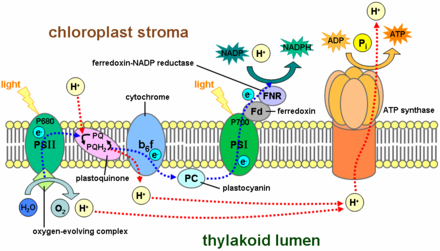 Photosynthesis functions by an elaborate electron transport chain within the thylakoid membrane. A central "link" in this chain is plastocyanin, a blue copper protein.
Photosynthesis functions by an elaborate electron transport chain within the thylakoid membrane. A central "link" in this chain is plastocyanin, a blue copper protein.
Dietary needs
Copper is an essential trace element in plants and animals, but not some microorganisms. The human body contains copper at a level of about 1.4 to 2.1 mg per kg of body mass.[81] Stated differently, the RDA for copper in normal healthy adults is quoted as 0.97 mg/day and as 3.0 mg/day.[82] Copper is absorbed in the gut, then transported to the liver bound to albumin. It enters the bloodstream via the plasma protein called ceruloplasmin, where its metabolism is controlled, and is excreted in bile.[83]
Copper-based disorders
Because of its role in facilitating iron uptake, copper deficiency can produce anemia-like symptoms, neutropenia, bone abnormalities, hypopigmentation, impaired growth, increased incidence of infections, osteoporosis, and abnormalities in glucose and cholesterol metabolism. Conversely, an accumulation of copper in body tissues causes Wilson's disease. Severe deficiency can be found by testing for low plasma or serum copper levels, low ceruloplasmin, and low red blood cell superoxide dismutase levels; these are not sensitive to marginal copper status. The "cytochrome c oxidase activity of leucocytes and platelets" has been stated as another factor in deficiency, but the results have not been confirmed by replication.[84]
Antimicrobial properties
Main articles: Antimicrobial properties of copper and Antimicrobial copper-alloy touch surfacesNumerous antimicrobial efficacy studies have been conducted in the past 10 years regarding copper’s efficacy to destroy a wide range of bacteria, as well as influenza A virus, adenovirus, and fungi.[68]
Extensive EPA-sanctioned tests using Good Laboratory Practices have found that when cleaned regularly, some 355 different EPA-registered antimicrobial copper alloy surfaces:
- Continuously reduce bacterial contamination, achieving 99.9% reduction within two hours of exposure;
- Kill greater than 99.9% of Gram-negative and Gram-positive bacteria within two hours of exposure;
- Deliver continuous and ongoing antibacterial action, remaining effective in killing greater than 99.9% of bacteria within two hours;
- Kill greater than 99.9% of bacteria within two hours, and continue to kill 99% of bacteria even after repeated contamination;
- Help inhibit the buildup and growth of bacteria within two hours of exposure between routine cleaning and sanitizing steps.
- Testing demonstrates effective antibacterial activity against E. coli O157:H7, methicillin-resistant Staphylococcus aureus (MRSA), Staphylococcus Epidermidis, Enterobacter aerogenes, and Pseudomonas aeruginosa.
Several of the aforementioned bacteria are responsible for a large portion of the nearly two million hospital-acquired infections contracted each year in the United States.[85]
Precautions
Gram quantities of various copper salts have been taken in suicide attempts and produced acute copper toxicity in humans, possibly due to redox cycling and the generation of reactive oxygen species that damage DNA.[86] Corresponding amounts of copper salts (30 mg/kg) are toxic in animals.[87] A minimum dietary value for healthy growth in rabbits has been reported to be at least 3 ppm in the diet.[88] However, higher concentrations of copper (100 ppm, 200 ppm, or 500 ppm) in the diet of rabbits may favorably influence feed conversion efficiency, growth rates, and carcass dressing percentages.[89]
Chronic copper toxicity does not normally occur in humans because of transport systems that regulate absorption and excretion. Autosomal recessive mutations in copper transport proteins can disable these systems, leading to Wilson's disease with copper accumulation and cirrhosis of the liver in persons who have inherited two defective genes.[81]
See also
- Electroplating
- Erosion corrosion of copper water tubes
- Metal theft
- Smelter
- Peak copper
- Category:Copper mining companies
References
- ^ a b c George L. Trigg; Edmund H. Immergut (1 November 1992). Encyclopedia of applied physics. 4: Combustion to Diamagnetism. VCH Publishers. pp. 267–272. ISBN 9783527281268. http://books.google.com/books?id=sVQ5RAAACAAJ. Retrieved 2 May 2011.
- ^ Smith, William F. and Hashemi, Javad (2003). Foundations of Materials Science and Engineering. McGraw-Hill Professional. p. 223. ISBN 0072921943.
- ^ a b c Hammond, C. R. (2004). The Elements, in Handbook of Chemistry and Physics 81st edition. CRC press. ISBN 0849304857.
- ^ Resistance Welding Manufacturing Alliance (2003). Resistance Welding Manual (4th ed.). Resistance Welding Manufacturing Alliance. pp. 18–12. ISBN 0-9624382-0-0.
- ^ "Galvanic Corrosion". Corrosion Doctors. http://www.corrosion-doctors.org/Forms-galvanic/galvanic-corrosion.htm. Retrieved 29 April 2011.
- ^ Chambers, William; Chambers, Robert (1884). Chambers's Information for the People. L (5th ed.). W. & R. Chambers. p. 312. ISBN 0665469128. http://books.google.com/?id=eGIMAAAAYAAJ.
- ^ a b c Holleman, A. F.; Wiberg, N. (2001). Inorganic Chemistry. San Diego: Academic Press. ISBN 978-0-12-352651-9.
- ^ "Copper.org: Education: Statue of Liberty: Reclothing the First Lady of Metals – Repair Concerns". Copper.org. http://www.copper.org/education/liberty/liberty_reclothed1.html. Retrieved 11 April 2011.
- ^ Rickett, B. I.; Payer, J. H. (1995). "Composition of Copper Tarnish Products Formed in Moist Air with Trace Levels of Pollutant Gas: Hydrogen Sulfide and Sulfur Dioxide/Hydrogen Sulfide". Journal of the Electrochemical Society 142 (11): 3723–3728. doi:10.1149/1.2048404.
- ^ Richardson, Wayne (1997). Handbook of copper compounds and applications. New York: Marcel Dekker. ISBN 9780585364490. OCLC 47009854.
- ^ a b Audi, G (2003). "Nubase2003 Evaluation of Nuclear and Decay Properties". Nuclear Physics A (Atomic Mass Data Center) 729: 3. Bibcode 2003NuPhA.729....3A. doi:10.1016/j.nuclphysa.2003.11.001.
- ^ "Interactive Chart of Nuclides". National Nuclear Data Center. http://www.nndc.bnl.gov/chart/reCenter.jsp?z=29&n=35. Retrieved 2011-04-08.
- ^ Okazawa, Hidehiko et al. (1994). "Clinical Application and Quantitative Evaluation of Generator-Produced Copper-62-PTSM as a Brain Perfusion Tracer for PET" (PDF). Journal of Nuclear Medicine 35 (12): 1910–1915. PMID 7989968. http://jnm.snmjournals.org/cgi/reprint/35/12/1910.pdf.
- ^ Rickwood, P. C. (1981). "The largest crystals". American Mineralogist 66: 885. http://www.minsocam.org/ammin/AM66/AM66_885.pdf.
- ^ a b c d Emsley, John (11 August 2003). Nature's building blocks: an A-Z guide to the elements. Oxford University Press. pp. 121–125. ISBN 9780198503408. http://books.google.com/books?id=j-Xu07p3cKwC&pg=PA123. Retrieved 2 May 2011.
- ^ Romano, Donatella; Matteucci, Fransesca (2007). "Contrasting copper evolution in ω Centauri and the Milky Way". Monthly Notices of the Royal Astronomical Society: Letters 378 (1): L59-L63. arXiv:astro-ph/0703760. Bibcode 2007MNRAS.378L..59R. doi:10.1111/j.1745-3933.2007.00320.x.
- ^ Gordon, R. B.; Bertram, M.; Graedel, T. E. (2006). "Metal stocks and sustainability". PNAS 103 (5): 1209–1214. Bibcode 2006PNAS..103.1209G. doi:10.1073/pnas.0509498103. PMC 1360560. PMID 16432205. http://www.pnas.org/content/103/5/1209.full.
- ^ Brown, Lester (2006). Plan B 2.0: Rescuing a Planet Under Stress and a Civilization in Trouble. New York: W.W. Norton. p. 109. ISBN 0393328317.
- ^ Leonard, Andrew (2006-03-02). "Peak copper?". Salon – How the World Works. http://www.salon.com/tech/htww/2006/03/02/peak_copper/index.html. Retrieved 2008-03-23.
- ^ Schmitz, Christopher (1986). "The Rise of Big Business in the World, Copper Industry 1870–1930". Economic History Review. 2 39 (3): 392–410. JSTOR 2596347.
- ^ "Copper Trends: Live Metal Spot Prices". http://metalspotprice.com/copper-trends/.
- ^ Ackerman, R. (02-04-2009). "A Bottom In Sight For Copper". Forbes. http://www.forbes.com/2009/02/04/copper-frontera-southern-markets-equity-0205_china_51.html.
- ^ a b Greenwood, Norman N.; Earnshaw, Alan (1997). Chemistry of the Elements (2nd ed.). Oxford: Butterworth-Heinemann. ISBN 0080379419.
- ^ Watling, H. R. (2006). "The bioleaching of sulphide minerals with emphasis on copper sulphides — A review" (PDF). Hydrometallurgy 84 (1, 2): 81–108. http://infolib.hua.edu.vn/Fulltext/ChuyenDe/ChuyenDe07/CDe53/59.pdf.
- ^ Samans, Carl (1949). Engineering metals and their alloys. New York: Macmillan. OCLC 716492542.
- ^ "International Copper Association". http://www.copperinfo.com/environment/recycling.html.
- ^ "Overview of Recycled Copper" ''Copper.org''. Copper.org (2010-08-25). Retrieved on 2011-11-08.
- ^ a b Wiley-Vch, (2007-04-02). "Nonsystematic (Contact) Fungicides". Ullmann's Agrochemicals. p. 623. ISBN 9783527316045. http://books.google.com/books?id=cItuoO9zSjkC&pg=PA623.
- ^ Ralph L. Shriner, Christine K. F. Hermann, Terence C. Morrill, David Y. Curtin, Reynold C. Fuson "The Systematic Identification of Organic Compounds" 8th edition, J. Wiley, Hoboken. ISBN 10 0-471-21503-1
- ^ Kay Saalwächter, Walther Burchard, Peter Klüfers, G. Kettenbach, and Peter Mayer, Dieter Klemm, Saran Dugarmaa "Cellulose Solutions in Water Containing Metal Complexes" Macromolecules 2000, 33, 4094–4107. doi:10.1021/ma991893m
- ^ "Modern Organocopper Chemistry" Norbert Krause, Ed., Wiley-VCH, Weinheim, 2002. ISBN 9783527297733.
- ^ Berná, José; Goldup, Stephen; Lee, Ai-Lan; Leigh, David; Symes, Mark; Teobaldi, Gilberto; Zerbetto, Fransesco (May 26, 2008). "Cadiot–Chodkiewicz Active Template Synthesis of Rotaxanes and Switchable Molecular Shuttles with Weak Intercomponent Interactions". Angewandte Chemie 120 (23): 4464–4468. doi:10.1002/ange.200800891.
- ^ Rafael Chinchilla and Carmen Nájera (2007). "The Sonogashira Reaction: A Booming Methodology in Synthetic Organic Chemistry". Chemical Reviews 107 (3): 874–922. doi:10.1021/cr050992x. PMID 17305399.
- ^ "An Addition of an Ethylcopper Complex to 1-Octyne: (E)-5-Ethyl-1,4-Undecadiene" (PDF). Organic Syntheses 64: 1. 1986. http://www.orgsyn.org/orgsyn/pdfs/CV7P0236.pdf.
- ^ Kharasch, M. S.; Tawney, P. O. (1941). "Factors Determining the Course and Mechanisms of Grignard Reactions. II. The Effect of Metallic Compounds on the Reaction between Isophorone and Methylmagnesium Bromide". Journal of the American Chemical Society 63 (9): 2308–2316. doi:10.1021/ja01854a005.
- ^ Sadako Imai et al. (1998). "63Cu NMR Study of Copper(I) Carbonyl Complexes with Various Hydrotris(pyrazolyl)borates: Correlation between 63Cu Chemical Shifts and CO Stretching Vibrations". Inorg. Chem. 37: 3066–3070. doi:10.1021/ic970138r.
- ^ Lewis, E. A.; Tolman, W. B. (2004). "Reactivity of Dioxygen-Copper Systems". Chemical Reviews 104: 1047–1076. doi:10.1021/cr020633r.
- ^ McDonald, M. R.; Fredericks, F. C.; Margerum, D. W. (1997). "Characterization of Copper(III)-Tetrapeptide Complexes with Histidine as the Third Residue". Inorganic Chemistry 36: 3119–3124. doi:10.1021/ic9608713. PMID 11669966.
- ^ a b "CSA – Discovery Guides, A Brief History of Copper". Csa.com. http://www.csa.com/discoveryguides/copper/overview.php. Retrieved 2008-09-12.
- ^ Rayner W. Hesse (2007). Jewelrymaking through History: an Encyclopedia. Greenwood Publishing Group. p. 56. ISBN 0313335079.
- ^ "Copper". Elements.vanderkrogt.net. http://elements.vanderkrogt.net/element.php?sym=Cu. Retrieved 2008-09-12.
- ^ Cowen, R.. "Essays on Geology, History, and People, Chapter 3: "Fire and Metals: Copper". http://www.geology.ucdavis.edu/~cowen/~GEL115/115CH3.html. Retrieved 2009-07-07.
- ^ Timberlake, S. and Prag A.J.N.W. (2005). The Archaeology of Alderley Edge: Survey, excavation and experiment in an ancient mining landscape. Oxford: John and Erica Hedges Ltd.. p. 396.
- ^ a b "CSA – Discovery Guides, A Brief History of Copper". CSA Discovery Guides. http://www.csa.com/discoveryguides/copper/overview.php. Retrieved 29 April 2011.
- ^ Pleger, Thomas C. "A Brief Introduction to the Old Copper Complex of the Western Great Lakes: 4000–1000 BC", Proceedings of the Twenty-seventh Annual Meeting of the Forest History Association of Wisconsin, Oconto, Wisconsin, October 5, 2002, pp. 10–18.
- ^ Emerson, Thomas E. and McElrath, Dale L. Archaic Societies: Diversity and Complexity Across the Midcontinent, SUNY Press, 2009 ISBN 1-4384-2701-8.
- ^ a b McNeil, Ian (2002). Encyclopaedia of the History of Technology. London ; New York: Routledge. pp. 13, 48–66. ISBN 0203192117.
- ^ Rickard, T. A. (1932). "The Nomenclature of Copper and its Alloys". The Journal of the Royal Anthropological Institute of Great Britain and Ireland (The Journal of the Royal Anthropological Institute of Great Britain and Ireland, Vol. 62) 62: 281. doi:10.2307/2843960. JSTOR 2843960.
- ^ Martin, Susan R. (1995). "The State of Our Knowledge About Ancient Copper Mining in Michigan". The Michigan Archaeologist 41 (2–3): 119. http://www.ramtops.co.uk/copper.html.
- ^ Hong, S.; Candelone, J.-P.; Patterson, C. C.; Boutron, C. F. (1996). "History of Ancient Copper Smelting Pollution During Roman and Medieval Times Recorded in Greenland Ice". Science 272 (5259): 246–249 (247f.). Bibcode 1996Sci...272..246H. doi:10.1126/science.272.5259.246.
- ^ de Callataÿ, François (2005). "The Graeco-Roman Economy in the Super Long-Run: Lead, Copper, and Shipwrecks". Journal of Roman Archaeology 18: 361–372 (366–369).
- ^ Jacobson, D. M.; Warman, John M.; Barentsen, Helma M.; van Dijk, Marinus; Zuilhof, Han; Sudhölter, Ernst J. R. (2000). "Corinthian Bronze and the Gold of the Alchemists". Macromolecules 33 (2): 60. Bibcode 2000MaMol..33...60S. doi:10.1021/ma9904870. http://www.goldbulletin.org/downloads/JACOB_2_33.PDF.
- ^ "World Mysteries – Strange Artifacts, Baghdad Battery". World-Mysteries.com. http://www.world-mysteries.com/sar_11.htm. Retrieved 22 April 2011.
- ^ Lynch, Martin (2004-04-15). Mining in World History. p. 60. ISBN 9781861891730. http://books.google.com/books?id=4yp-x3TzDnEC&pg=PA60.
- ^ "Gold: prices, facts, figures and research: A brief history of money". http://www.galmarley.com/FAQs_pages/monetary_history_faqs.htm#Scandinavian%20copper%20money. Retrieved 22 April 2011.
- ^ "Copper History". http://www.copperinfo.com/aboutcopper/history.html. Retrieved 2008-09-04.
- ^ Stelter, M.; Bombach, H. (2004). "Process Optimization in Copper Electrorefining". Advanced Engineering Materials 6 (7): 558. doi:10.1002/adem.200400403.
- ^ "Outokumpu Flash Smelting". Outokumpu. p. 2. http://www.outokumpu.com/files/Technology/Documents/Newlogobrochures/FlashSmelting.pdf.
- ^ Karen A. Mingst (1976). "Cooperation or illusion: an examination of the intergovernmental council of copper exporting countries". International Organization 30 (2): 263–287. doi:10.1017/S0020818300018270.
- ^ "Copper". American Elements. 2008. http://www.americanelements.com/cu.html. Retrieved 2008-07-12.
- ^ "Accelerator: Waveguides (SLAC VVC)". SLAC Virtual Visitor Center. http://www2.slac.stanford.edu/vvc/accelerators/waveguide.html. Retrieved 29 April 2011.
- ^ Berg, Jan. "Why did we paint the library's roof?". Archived from the original on 2007-06-25. http://web.archive.org/web/20070625065039/http://www.deforest.lib.wi.us/FAQS.htm. Retrieved 2007-09-20.
- ^ ASTM B 152, Standard Specification for Copper Sheet, Strip, Plate, and Rolled Bar.
- ^ Physics 1, Jacaranda Science. 3rd Ed.. 2009.
- ^ Davis, Joseph R. (2001). Copper and Copper Alloys. ASM International. pp. 3–6, 266. ISBN 0871707268.
- ^ "Gold Jewellery Alloys". World Gold Council. http://www.utilisegold.com/jewellery_technology/colours/colour_alloys/. Retrieved 2009-06-06.
- ^ Balver Zinn Solder Sn97Cu3. (PDF) . balverzinn.com. Retrieved on 2011-11-08.
- ^ a b Copper Touch Surfaces. Copper Touch Surfaces. Retrieved on 2011-11-08.
- ^ a b EPA registers copper-containing alloy products, May 2008
- ^ Biurrun, Amaya; Caballero, Luis; Pelaz, Carmen; León, Elena; Gago, Alberto (1999). "Treatment of a Legionella pneumophila‐Colonized Water Distribution System Using Copper‐Silver Ionization and Continuous Chlorination". Infection Control and Hospital Epidemiology 20 (6): 426–428. doi:10.1086/501645. JSTOR 30141645.
- ^ Chilean subway protected with Antimicrobial Copper – Rail News from. rail.co. Retrieved on 2011-11-08.
- ^ Codelco to provide antimicrobial copper for new metro lines (Chile). Construpages.com.ve. Retrieved on 2011-11-08.
- ^ PR 811 Chilean Subway Installs Antimicrobial Copper. (PDF). antimicrobialcopper.com. Retrieved on 2011-11-08.
- ^ Edding, Mario E., Flores, Hector, and Miranda, Claudio, (1995), Experimental Usage of Copper-Nickel Alloy Mesh in Mariculture. Part 1: Feasibility of usage in a temperate zone; Part 2: Demonstration of usage in a cold zone; Final report to the International Copper Association Ltd.
- ^ Corrosion Behaviour of Copper Alloys used in Marine Aquaculture. (PDF) . copper.org. Retrieved on 2011-11-08.
- ^ "Antimicrobial Products that Shield Against Bacteria and Fungi". Cupron, Inc.. 2008. http://www.cupron.com/. Retrieved 2008-07-13.
- ^ Walker, W. R.; Keats, D. M. (1976). "An investigation of the therapeutic value of the 'copper bracelet'-dermal assimilation of copper in arthritic/rheumatoid conditions". Agents Actions 6 (4): 454–459. PMID 961545.
- ^ a b c S. J. Lippard, J. M. Berg “Principles of bioinorganic chemistry” University Science Books: Mill Valley, CA; 1994. ISBN 0-935702-73-3.
- ^ Decker, H. and Terwilliger, N. (2000). "COPs and Robbers: Putative evolution of copper oxygen-binding proteins". Journal of Experimental Biology 203: 1777–1782. PMID 10821735.
- ^ "Fun facts". Horseshoe crab. University of Delaware. http://www.ocean.udel.edu/horseshoecrab/funFacts.html. Retrieved 2008-07-13.
- ^ a b "Amount of copper in the normal human body, and other nutritional copper facts". http://www.copper.org/consumers/health/papers/cu_health_uk/cu_health_uk.html. Retrieved April 3, 2009.
- ^ Copper. In: Recommended Dietary Allowances. Washington, D.C.: National Research Council, Food Nutrition Board, NRC/NAS. 1980. pp. 151–154.
- ^ Adelstein, S. J.; Vallee, B. L. (1961). "Copper metabolism in man". New England Journal of Medicine 265: 892–897. doi:10.1056/NEJM196111022651806.
- ^ Bonham, M. et al. (2002). "The immune system as a physiological indicator of marginal copper status?". British Journal of Nutrition 87 (5): 393–403. doi:10.1079/BJN2002558. PMID 12010579.
- ^ "Center for Disease Control and Prevention". http://www.cdc.gov/ncidod/eid/vol7no2/pdfs/peterson.pdf. Retrieved 2009-06-06.
- ^ Li, Yunbo; Trush, Michael; Yager, James (1994). "DNA damage caused by reactive oxygen species originating from a copper-dependent oxidation of the 2-hydroxy catechol of estradiol". Carcinogenesis 15 (7): 1421–1427. doi:10.1093/carcin/15.7.1421. PMID 8033320.
- ^ "Pesticide Information Profile for Copper Sulfate". Cornell University. http://pmep.cce.cornell.edu/profiles/extoxnet/carbaryl-dicrotophos/copper-sulfate-ext.html. Retrieved 2008-07-10.
- ^ Hunt, Charles E. and William W. Carlton (1965). "Cardiovascular Lesions Associated with Experimental Copper Deficiency in the Rabbit". Journal of Nutrition 87: 385–394. PMID 5841854.
- ^ Ayyat M.S., Marai I.F.M., Alazab A.M. (1995). "Copper-Protein Nutrition of New Zealand White Rabbits under Egyptian Conditions". World Rabbit Science 3: 113–118. http://riunet.upv.es/handle/10251/10503?locale-attribute=en.
Notes
Pourbaix diagrams for copper in pure water, or acidic or alkali conditions. Copper in neutral water is more noble than hydrogen. in water containing sulfide in 10 M ammonia solution in a chloride solution Further reading
- Massaro, Edward J., ed (2002). Handbook of Copper Pharmacology and Toxicology. Humana Press. ISBN 0-89603-943-9.
- "Copper: Technology & Competitiveness (Summary) Chapter 6: Copper Production Technology". Office of Technology Assessment. 2005. http://www.princeton.edu/~ota/disk2/1988/8808/880808.PDF.
- Current Medicinal Chemistry, Volume 12, Number 10, May 2005, pp. 1161–1208(48) Metals, Toxicity and Oxidative Stress
- William D. Callister (2003). Materials Science and Engineering: an Introduction, 6th Ed.. Table 6.1, p. 137: Wiley, New York. ISBN 0471736961.
- Material: Copper (Cu), bulk, MEMS and Nanotechnology Clearinghouse.
- Kim BE, Nevitt T, Thiele DJ (2008). "Mechanisms for copper acquisition, distribution and regulation". Nat. Chem. Biol. 4 (3): 176. doi:10.1038/nchembio.72. PMID 18277979. http://www.nature.com/nchembio/journal/v4/n3/abs/nchembio.72.html.
- Copper transport disorders: an Instant insight from the Royal Society of Chemistry
External links
- National Pollutant Inventory – Copper and compounds fact sheet
- Copper Resource Page. Includes 12 PDF files detailing the material properties of various kinds of copper, as well as various guides and tools for the copper industry.
- The Copper Development Association has an extensive site of properties and uses of copper; it also maintains a web site dedicated to brass, a copper alloy.
- The Third Millennium Online page on Copper
- Price history of copper, according to the IMF
Periodic table H He Li Be B C N O F Ne Na Mg Al Si P S Cl Ar K Ca Sc Ti V Cr Mn Fe Co Ni Cu Zn Ga Ge As Se Br Kr Rb Sr Y Zr Nb Mo Tc Ru Rh Pd Ag Cd In Sn Sb Te I Xe Cs Ba La Ce Pr Nd Pm Sm Eu Gd Tb Dy Ho Er Tm Yb Lu Hf Ta W Re Os Ir Pt Au Hg Tl Pb Bi Po At Rn Fr Ra Ac Th Pa U Np Pu Am Cm Bk Cf Es Fm Md No Lr Rf Db Sg Bh Hs Mt Ds Rg Cn Uut Uuq Uup Uuh Uus Uuo Alkali metals Alkaline earth metals Lanthanides Actinides Transition metals Other metals Metalloids Other nonmetals Halogens Noble gases Unknown chem. properties Large version Chemical elements named after places Named after terrestrial places Named after astronomical objects Copper compounds Jewellery Forms Anklet · Belt buckle · Belly chain · Bindi · Bracelet · Brooch · Chatelaine · Collar pin · Crown · Cufflink · Earring · Lapel pin · Necklace · Pendant · Ring · Tiara · Tie clip · Toe ring · Watch (pocket)Making PeopleProcessesCasting (centrifugal, lost-wax, vacuum) · Enameling · Engraving · Filigree · Metal clay · Plating · Polishing · Repoussé and chasing · Soldering · Stonesetting · Wire wrappingToolsMaterials Britannia silver · Colored gold · Crown gold · Electrum · Platinum sterling · Shakudo · Shibuichi · Sterling silver · TumbagaMineral gemstonesAventurine · Agate · Alexandrite · Amethyst · Aquamarine · Carnelian · Citrine · Diamond · Diopside · Emerald · Garnet · Jade · Jasper · Lapis lazuli · Larimar · Malachite · Marcasite · Moonstone · Obsidian · Onyx · Opal · Peridot · Quartz · Ruby · Sapphire · Sodalite · Sunstone · Tanzanite · Tiger's eye · Topaz · Tourmaline · TurquoiseOrganic gemstonesTerms Categories:- Copper
- Chemical elements
- Dietary minerals
- Electrical conductors
- Symbols of Utah
- Transition metals
- Biology and pharmacology of chemical elements
- Cubic minerals
Wikimedia Foundation. 2010.

